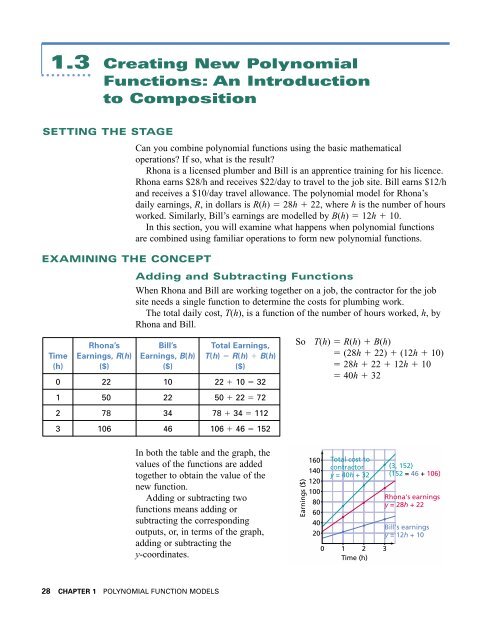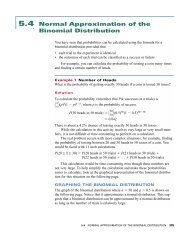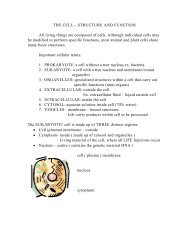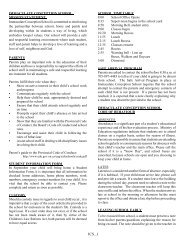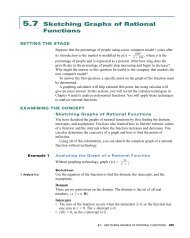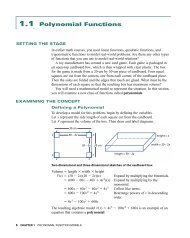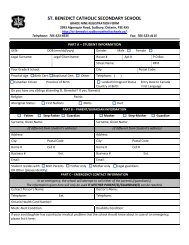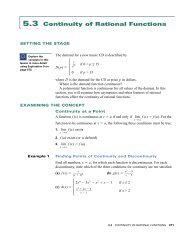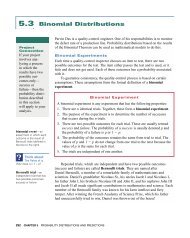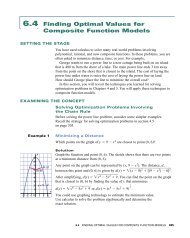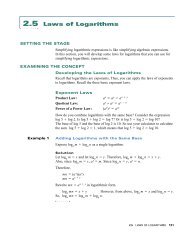1.3 Creating New Polynomial Functions: An Introduction to ...
1.3 Creating New Polynomial Functions: An Introduction to ...
1.3 Creating New Polynomial Functions: An Introduction to ...
You also want an ePaper? Increase the reach of your titles
YUMPU automatically turns print PDFs into web optimized ePapers that Google loves.
<strong>1.3</strong> <strong>Creating</strong> <strong>New</strong> <strong>Polynomial</strong><br />
<strong>Functions</strong>: <strong>An</strong> <strong>Introduction</strong><br />
<strong>to</strong> Composition<br />
SETTING THE STAGE<br />
EXAMINING THE CONCEPT<br />
Can you combine polynomial functions using the basic mathematical<br />
operations If so, what is the result<br />
Rhona is a licensed plumber and Bill is an apprentice training for his licence.<br />
Rhona earns $28/h and receives $22/day <strong>to</strong> travel <strong>to</strong> the job site. Bill earns $12/h<br />
and receives a $10/day travel allowance. The polynomial model for Rhona’s<br />
daily earnings, R, in dollars is R(h) 28h 22, where h is the number of hours<br />
worked. Similarly, Bill’s earnings are modelled by B(h) 12h 10.<br />
In this section, you will examine what happens when polynomial functions<br />
are combined using familiar operations <strong>to</strong> form new polynomial functions.<br />
Adding and Subtracting <strong>Functions</strong><br />
When Rhona and Bill are working <strong>to</strong>gether on a job, the contrac<strong>to</strong>r for the job<br />
site needs a single function <strong>to</strong> determine the costs for plumbing work.<br />
The <strong>to</strong>tal daily cost, T(h), is a function of the number of hours worked, h, by<br />
Rhona and Bill.<br />
Rhona’s Bill’s Total Earnings,<br />
Time Earnings, R(h) Earnings, B(h) T(h) R(h) B(h)<br />
(h) ($) ($) ($)<br />
0 22 10 22 10 32<br />
1 50 22 50 22 72<br />
2 78 34 78 34 112<br />
3 106 46 106 46 152<br />
So<br />
T(h) R(h) B(h)<br />
(28h 22) (12h 10)<br />
28h 22 12h 10<br />
40h 32<br />
In both the table and the graph, the<br />
values of the functions are added<br />
<strong>to</strong>gether <strong>to</strong> obtain the value of the<br />
new function.<br />
Adding or subtracting two<br />
functions means adding or<br />
subtracting the corresponding<br />
outputs, or, in terms of the graph,<br />
adding or subtracting the<br />
y-coordinates.<br />
Earnings ($)<br />
160<br />
140<br />
120<br />
100<br />
80<br />
60<br />
40<br />
20<br />
Total cost <strong>to</strong><br />
contrac<strong>to</strong>r<br />
y = 40h + 32<br />
0 1 2 3<br />
Time (h)<br />
(3, 152)<br />
(152 = 46 + 106)<br />
Rhona's earnings<br />
y = 28h + 22<br />
Bill's earnings<br />
y = 12h + 10<br />
28 CHAPTER 1 POLYNOMIAL FUNCTION MODELS
Example 1<br />
Subtracting Two <strong>Polynomial</strong> <strong>Functions</strong><br />
Let f (x) 2(x 1)(x 2)(x 4) and g(x) (x 1)(x 2)(x 4).<br />
(a) On the same axes, sketch the graph of each function. Use intercepts, the<br />
degree of the function, and the leading coefficient <strong>to</strong> develop the sketch.<br />
(b) Graph h(x) f (x) g(x).<br />
(c) Identify the domain of each function.<br />
9<br />
6<br />
3<br />
–3 –2 –1<br />
–3<br />
–6<br />
–9<br />
–12<br />
–15<br />
–18<br />
y<br />
Solution<br />
y = g(x)<br />
x<br />
1 2 3 4 5 6<br />
y = f(x)<br />
(a) The zeros for both f (x) and g(x) are 1, 2, and 4.<br />
By inspection, both functions are degree-3 polynomials.<br />
The leading coefficient of f (x) is negative.<br />
Therefore, as x → ∞, f (x) →∞and as x →∞, f (x) → ∞.<br />
For g(x), the leading coefficient is positive.<br />
Therefore, as x → ∞, g(x) → ∞ and as x →∞, g(x) →∞.<br />
The y-intercept of g(x) is 8 and the y-intercept of f (x) is 16.<br />
Using this information results in the sketch <strong>to</strong> the left.<br />
y<br />
12<br />
y = h(x)<br />
8<br />
y = g(x)<br />
4<br />
x<br />
–3 –2 –1<br />
–4<br />
–8<br />
–12<br />
1 2 3 4 5 6<br />
–16<br />
–20<br />
y = f(x)<br />
–24<br />
–28<br />
–32<br />
f (x), g(x), and h(x) f (x) g(x)<br />
(b) h(x) f (x) g(x)<br />
To find points that lie on h(x), subtract the y-coordinates of points<br />
that have the same x-coordinate. The difference function has the<br />
same zeros as the two original functions, that is, 1, 2, and 4.<br />
Subtracting the y-intercepts results in point (0, 24). Create a table<br />
<strong>to</strong> record some additional key points on f and g, and use these <strong>to</strong><br />
find more points on h.<br />
x f (x) g(x) h(x) f (x) g(x)<br />
1 12 6 12 6 18<br />
3 8 4 8 (4) 12<br />
5 36 18 36 18 54<br />
(c) Since f (x) and g(x) are polynomial functions, their domains are the same,<br />
that is, the set of real numbers. The difference function h(x) is also a<br />
polynomial function, and its domain is also the set of real numbers.<br />
For any two functions, the y-values can only be added or subtracted when<br />
the x-values are common. For any polynomial function, the domain is the set<br />
of real numbers, so the difference, or sum, function will have the same<br />
domain, the set of real numbers. However, the range of f (x) ± g(x) must be<br />
determined each time.<br />
<strong>1.3</strong> CREATING NEW POLYNOMIAL FUNCTIONS: AN INTRODUCTION TO COMPOSITION 29
EXAMINING THE CONCEPT<br />
Multiplying Two <strong>Polynomial</strong> <strong>Functions</strong><br />
What is the result when two polynomial functions are multiplied<br />
Example 2<br />
Multiplying Two <strong>Polynomial</strong> <strong>Functions</strong><br />
Let f (x) x 3 and g(x) x 2 5, x ∈ R.<br />
(a) Sketch each graph on the same axes.<br />
(b) Make a table for 3 ≤ x ≤ 3, and determine the corresponding values of<br />
h(x) f (x) g(x).<br />
(c) Use the table <strong>to</strong> sketch h(x) on the same axes. Describe the shape of the<br />
graph.<br />
(d) Determine the algebraic model for h(x). What is its degree<br />
(e) What is the domain of h(x) How does this domain compare with the<br />
domains of f (x) and g(x)<br />
10<br />
8<br />
6<br />
4<br />
2<br />
–5 –4 –3 –2 –1<br />
–2<br />
y = h(x)<br />
18<br />
15<br />
12<br />
9<br />
6<br />
y<br />
–4<br />
–6<br />
–8<br />
–10<br />
3<br />
x<br />
–3 –2 –1 1 2 3<br />
–3<br />
–6<br />
y = g(x)<br />
–9<br />
y<br />
Solution<br />
y = f(x)<br />
1 2 3 4 5<br />
y = f(x)<br />
y = g(x)<br />
x<br />
(a) Use intercepts <strong>to</strong> sketch the graphs.<br />
The graph of function f (x) is linear with slope 1 and<br />
y-intercept 3.<br />
The graph of function g(x) is quadratic with vertex (0, 5).<br />
The parabola opens down.<br />
(b)<br />
f (x) x 3 g(x) x 2 5 h(x) f (x) g(x)<br />
3 0 4 0 (4) 0<br />
2 1 1 1 1 1<br />
1 2 4 2 4 8<br />
0 3 5 3 5 15<br />
1 4 4 4 4 16<br />
2 5 1 5 1 5<br />
3 6 4 6 (4) 24<br />
(c) The graph of h(x) is a cubic polynomial.<br />
(d) h(x) f (x) g(x)<br />
(x 3)(x 2 5)<br />
x 3 3x 2 5x 15<br />
This polynomial function has degree 3.<br />
(e) The domain of h(x) is the set of real numbers, which is the same as the<br />
domains of f (x) and g(x).<br />
30 CHAPTER 1 POLYNOMIAL FUNCTION MODELS
Adding, Subtracting, and Multiplying<br />
<strong>Polynomial</strong> <strong>Functions</strong><br />
For the polynomial functions f and g,<br />
• the sum is ( f g)(x) f (x) g(x)<br />
• the difference is ( f g)(x) f (x) g(x)<br />
• the product is ( fg)(x) f (x) g(x)<br />
The domain of f ± g and fg is the set of all x, for which both f and g are<br />
defined. <strong>An</strong>y x belonging <strong>to</strong> the domain of f and <strong>to</strong> the domain of g belongs<br />
<strong>to</strong> the domain of f (x) ± g(x) or f (x) g(x).<br />
EXAMINING THE CONCEPT<br />
input → output<br />
x → g(x) → f (g(x))<br />
g f<br />
input → output<br />
The Composition of <strong>Functions</strong><br />
What happens when the output of one function is the input of another<br />
You can think of a function as an input-output machine. The input set<br />
is the domain of the function, and the output set is the range of the function.<br />
In the first step of the diagram, the x is an input and g(x) is an output.<br />
In the second step, g(x) is an input and f (g(x)) is an output.<br />
Combining two functions in this way is called composition. Composition is<br />
the result of substituting the output of one function in<strong>to</strong> another. The new<br />
function is called the composite of f and g and is written f g.<br />
Example 3<br />
Determining the Equation of a Composite Function<br />
Recall the situation in Setting the Stage. Rhona earns a daily wage according <strong>to</strong><br />
R(h) 28h 22. The job site where Rhona works requires all employees <strong>to</strong><br />
become members of a union. Rhona then pays 1.5% of her daily earnings as<br />
union dues. Determine the function that represents her daily union dues.<br />
Hours Worked<br />
h<br />
1<br />
2<br />
3<br />
.<br />
.<br />
.<br />
.<br />
8<br />
R<br />
Daily Earnings<br />
R(h)<br />
50<br />
78<br />
106<br />
.<br />
.<br />
.<br />
.<br />
246<br />
Solution<br />
U<br />
Union Dues<br />
U(R(h))<br />
0.75<br />
1.17<br />
1.59<br />
.<br />
.<br />
.<br />
.<br />
3.69<br />
This situation involves two functions,<br />
Daily Earnings: R(h) 28h 22<br />
Daily Union Dues: U(R(h)) 0.015 R(h)<br />
Examine the mapping that shows how the number of<br />
hours worked per day is related <strong>to</strong> the daily union dues.<br />
The domain for Rhona’s daily earnings is the number of<br />
hours worked. But the domain for the daily union dues<br />
are her daily earnings, not the number of hours worked.<br />
In other words, the domain of the substitution function is<br />
the range of the substituted function.<br />
<strong>1.3</strong> CREATING NEW POLYNOMIAL FUNCTIONS: AN INTRODUCTION TO COMPOSITION 31
Find the composite of the two functions.<br />
U(R(h)) 0.015(R(h))<br />
0.015(28h 22)<br />
0.42h 0.33<br />
The function U(R(h)) 0.42h 0.33 represents Rhona’s daily union dues.<br />
Composite <strong>Functions</strong><br />
For two functions f and g, the composite function f (g(x)) is formed by<br />
evaluating f at g(x). This new function is defined as f g. The domain of f g<br />
is a subset of the domain of g and is found by examining f g and comparing<br />
the domain of f with the range of g.<br />
Example 4<br />
Determining the Value of a Composite Function<br />
For the functions f {(4, 1), (3, 2), (2, 3)} and g {(1, 5), (2, 4), (4, 2)},<br />
determine each value.<br />
(a) f (g(4)) (b) g( f (4))<br />
Solution<br />
(a) First find the value of g where x 4. In the ordered pair (4, 2), x 4.<br />
Therefore, g(4) 2.<br />
Then f (g(4)) f (2). Now find the value of f where x 2.<br />
In the ordered pair (2, 3), x 2.<br />
So f (g(4)) f (2)<br />
3<br />
(b) Find the value of f where x 4. In the ordered pair (4, 1), x 4.<br />
Therefore, f (4) 1.<br />
Then g( f (4)) g(1). Now find the value of g where x 1.<br />
In the ordered pair (1, 5), x 1.<br />
So<br />
g( f (4)) g(1)<br />
5<br />
Example 5<br />
Applying a Composite Function<br />
Ali buys a pair of shoes and has a coupon for $15 off. The day he buys the<br />
shoes, the s<strong>to</strong>re has a sale offering 20% off the price of all shoes.<br />
(a) Write a function <strong>to</strong> represent the cost, C, of a pair of shoes at price, p, if just<br />
the coupon reduction is applied <strong>to</strong> the cost of the shoes. Write a function that<br />
represents the cost, D, if just the discount is applied <strong>to</strong> the cost.<br />
32 CHAPTER 1 POLYNOMIAL FUNCTION MODELS
(b) What does the function D(C(p)) represent if a pair of shoes has a regular<br />
price of $80 Determine D(C(80)).<br />
(c) What does the function C D represent for a pair of shoes with a regular<br />
price of $80 Determine C D for the same pair of shoes.<br />
(d) Does C D D C Justify your answer.<br />
Solution<br />
(a) C(p) p 15 and D(p) 0.8p<br />
(b) D(C(p)) means the coupon is applied first and then the<br />
discount is applied <strong>to</strong> the cost of the shoes. So, when p 80,<br />
D(C(80)) D(80 15)<br />
D(65)<br />
0.8(65)<br />
52<br />
(c) C D means the discount is taken first and then the coupon reduction is<br />
applied. When p 80,<br />
(C D)(x) C(D(80))<br />
C(0.8(80))<br />
C(64)<br />
64 15<br />
49<br />
(d) In this case, C D ≠ D C. The order of composition makes a difference.<br />
When p 80, D(C(80)) 52 and C(D(80)) 49. In fact, these two<br />
functions are different.<br />
(C D)(p) C(0.8p) (D C)(p) D(p 15)<br />
0.8p 15 0.8(p 15)<br />
0.8p 12<br />
CHECK, CONSOLIDATE, COMMUNICATE<br />
1. Explain how a new polynomial function can be made from two<br />
polynomial functions by addition, by subtraction, and by multiplication.<br />
2. State ( f g)(x), ( f g)(x), ( f g)(x), and f (g(x)) for<br />
f {(1, 4), (0, 5), (6, 3)} and g {(1, 6), (0, 9), (4, 2)}.<br />
3. Determine ( f g)(x), ( f g)(x), ( f g)(x), and f (g(x)) for<br />
f (x) x 2 3x 2 and g(x) x 3.<br />
<strong>1.3</strong> CREATING NEW POLYNOMIAL FUNCTIONS: AN INTRODUCTION TO COMPOSITION 33
KEY IDEAS<br />
• <strong>New</strong> polynomial functions can be made from other polynomial functions<br />
through addition, subtraction, multiplication, and composition.<br />
• The domain of a polynomial function that is the result of adding,<br />
subtracting, or multiplying other polynomial functions is the same as the<br />
common domain of the original polynomial functions.<br />
• For two functions f and g, the composite function f g f (g(x)) is formed<br />
by evaluating f at g. For f g, the domain of f is the range of g, provided<br />
that g is defined.<br />
<strong>1.3</strong> Exercises<br />
A<br />
1. Knowledge and Understanding: Let f {(4, 4), (2, 4), (1, 3), (3, 5),<br />
(4, 6)} and g {(4, 2), (2, 1), (0, 2), (1, 2), (2, 2), (4, 4)}. Determine<br />
(a) f g (b) f g (c) g f (d) fg<br />
2. Use the graph of f and g <strong>to</strong> sketch the graph of f g.<br />
(a)<br />
y<br />
(b)<br />
f<br />
7<br />
6<br />
5<br />
4<br />
3<br />
2<br />
g 1<br />
x<br />
–5 –4 –3 –2 –1 0<br />
–1<br />
1 2 3 4 5<br />
–2<br />
f<br />
7<br />
6<br />
5<br />
4<br />
3<br />
2<br />
1<br />
–5 –4 –3 –2 –1 0 1 2 3 4 5<br />
–1<br />
–2<br />
y<br />
g<br />
x<br />
3. Use the graph of f and g <strong>to</strong> sketch the graph of f g.<br />
(a)<br />
y<br />
7<br />
6<br />
5<br />
4<br />
f 3<br />
2<br />
1<br />
x<br />
–5 –4 –3 –2 –1 0 1 2 3 4 5<br />
g –1<br />
–2<br />
(b)<br />
y<br />
7<br />
6<br />
f<br />
5<br />
4<br />
3 g<br />
2<br />
1<br />
–5 –4 –3 –2 –1 0<br />
–1<br />
1 2 3 4 5<br />
–2<br />
x<br />
34 CHAPTER 1 POLYNOMIAL FUNCTION MODELS
4. Use the graph of f and g <strong>to</strong> sketch the graph of fg.<br />
(a)<br />
y<br />
7<br />
6<br />
f<br />
5<br />
4<br />
g<br />
3<br />
(b)<br />
2<br />
1<br />
x<br />
–3 –2 –1 0<br />
–1<br />
1 2 3 4 5 6 7<br />
–4 –3<br />
–2<br />
y<br />
7<br />
g 6<br />
5<br />
4<br />
3<br />
2<br />
1<br />
–2 –1 0<br />
–1<br />
1 2<br />
–2<br />
3<br />
f<br />
4<br />
x<br />
B<br />
5. Let f {(3, 2), (5, 1), (7, 4), (9, 3), (11, 5)} and<br />
g {(1, 3), (2, 5), (3, 7), (4, 9), (5, 11)}. Determine<br />
(a) f (g(3)) (b) g( f (9))<br />
6. Let f {(1, 3), (0, 2), (1, 3), (2, 6)} and<br />
g {(1, 0), (0, 1), (1, 2), (2, 3)}. Determine<br />
(a) f (g(x))<br />
(b) g( f (x))<br />
7. Let f (x) 3x 2 and g(x) 2x 4, x ∈ R. Determine an expression for<br />
each case, and state the domain of the expression.<br />
(a) ( f g)(x) (b) (g f )(x) (c) ( f g)(x) (d) ( fg)(x)<br />
8. Let f (x) 3x 1, 0 ≤ x ≤ 6, and g(x) x 2 6x, 1 ≤ x ≤ 4.<br />
Determine an expression for each case, and state the domain of<br />
the expression.<br />
(a) ( f g)(x) (b) ( f g)(x) (c) (g f )(x) (d) ( fg)(x)<br />
9. Let f (x) x 2 4 and g(x) 3x. Determine<br />
(a) f (g(1)) (b) g( f (2)) (c) g(g(1)) (d) f ( f (2))<br />
10. Communication: Consider two functions f and g.<br />
(a) Explain why the domains of f and g must be the same in order <strong>to</strong> add,<br />
subtract, or multiply the functions.<br />
(b) Explain why the domain of f is the range of g for f (g(x)).<br />
11. Let f {(1, 4), (0, 2), (1, 0), (2, 2)}.<br />
(a) Give an example of g if f g {(1, 6), (0, 4), (1, 2), ( 2, 0)}.<br />
(b) Give an example of g if fg {(1, 12), (0, 6), (1, 0), (2, 6)}.<br />
12. Let f (x) 3x 2, 2 ≤ x ≤ 4, and g(x) 4x 1, 3 ≤ x ≤ 5.<br />
(a) Graph f and g on the same axes.<br />
(b) Use appropriate ordered pairs <strong>to</strong> sketch the graph of f g.<br />
What is the domain of f g<br />
<strong>1.3</strong> CREATING NEW POLYNOMIAL FUNCTIONS: AN INTRODUCTION TO COMPOSITION 35
13. In each case, determine f (x) g(x) and draw its graph.<br />
(a) f (x) 2x 3, x ∈ R, and g(x) 3x 4, x ∈ R<br />
(b) f (x) 3x 2, x ∈ R, and g(x) x 2 3, x ∈ R<br />
(c) f (x) x 2 2, x ∈ R, and g(x) 2x 2 1, x ∈ R<br />
14. In each case, functions f and g are defined for x ∈ R. For each pair of<br />
functions, determine the expression and the domain for f (g(x)) and g( f (x)).<br />
Graph each result.<br />
(a) f (x) 3x 2 , g(x) x 1<br />
(b) f (x) 2x 2 x, g(x) x 2 1<br />
(c) f (x) 2x 3 3x 2 x 1, g(x) 2x 1<br />
(d) f (x) x 4 x 2 , g(x) x 1<br />
15. In each case, x ∈ R for f (x) and g(x). Graph f (x) and g(x) on the same axes<br />
and use this graph <strong>to</strong> graph h(x) f (x) g(x).<br />
(a) f (x) x 2 1 and g(x) 3<br />
(b) f (x) 2x 2 2 and g(x) 2x 2 1<br />
(c) f (x) (x 1)(x 2)(x 4) and g(x) (x 1)(x 4)(x 6)<br />
16. Verify your work in question 15 using a graphing calcula<strong>to</strong>r.<br />
17. Repeat question 15 for h(x) f (x) g(x).<br />
18. A company produces a product for $9.45 per unit, plus a fixed operating<br />
cost of $52 000. The company sells the product for $15.80 per unit.<br />
(a) Determine a function, C(x), <strong>to</strong> represent the cost of producing x units.<br />
(b) Determine a function, S(x), <strong>to</strong> represent sales of x units.<br />
(c) Determine a function that represents profit.<br />
19. Steve earns $24.39/h operating an industrial plasma <strong>to</strong>rch at a rail car<br />
manufacturing plant. He receives $0.58/h more for working the night shift,<br />
as well as $0.39/h for working weekends.<br />
(a) Write a function that describes Steve’s regular pay.<br />
(b) What function shows his night shift premium<br />
(c) What function shows his weekend premium<br />
(d) What function represents his earnings for the night shift on Saturday<br />
(e) How much does Steve earn for working 11 h on Saturday night, if he<br />
earns time and a half on that day’s rate for more than 8 h of work<br />
20. A circle has radius r.<br />
(a) Write a function for the circle’s area in terms of r.<br />
(b) Write a function for the radius in terms of the circumference, C.<br />
(c) Determine A(r(C)).<br />
(d) A tree’s circumference is 3.6 m. What is the area of the cross section<br />
36 CHAPTER 1 POLYNOMIAL FUNCTION MODELS
Johann Peter Gustav<br />
Lejeune Dirichlet<br />
(1805–1859)<br />
Originally, the<br />
definition of a function<br />
was much less precise<br />
than it is <strong>to</strong>day.<br />
Dirichlet was<br />
responsible for the<br />
definition of a function<br />
that we use <strong>to</strong>day.<br />
21. Application: A solar panel is used <strong>to</strong> power an overhead sign on a highway.<br />
Each square metre of solar panel receives about 200 W of solar power. This<br />
solar panel converts about 15% of the solar energy <strong>to</strong> electrical power.<br />
(a) Write a function for the solar power, S(A), measured in watts (W) for<br />
any given area, A, in square metres.<br />
(b) Write a function for the <strong>to</strong>tal electrical power, P(S), in watts (W) this<br />
solar panel can generate.<br />
(c) How large must the solar panel be if the sign uses 6 W of electrical<br />
energy<br />
22. Refrigeration slows down the growth of bacteria in food. The number of<br />
bacteria in a certain food is approximated by B(T) 15T 2 70T 600,<br />
where T represents the temperature in degrees Celsius and 3 ≤ T ≤ 12.<br />
Once the food is removed from refrigeration, the temperature, T(t),<br />
is given by T(t) 3.5t 3, where t is the time in hours and 0 ≤ t ≤ 3.<br />
(a) Write the expression for the number of bacteria in the food, t hours<br />
after it is removed from refrigeration.<br />
(b) At 1.5 h, about how many bacteria are in the food<br />
(c) When will the bacteria count reach about 1200<br />
23. A franchise owner operates two coffee shops. The sales, S 1<br />
, in thousands of<br />
dollars, for shop one are represented by S 1<br />
(t) 700 1.4t 2 , where t 0<br />
corresponds <strong>to</strong> the year 2000. Similarly, the sales for shop two are<br />
represented by S 2<br />
(t) t 3 3t 2 500.<br />
(a) Which shop is showing an increase in sales after the year 2000<br />
(b) Determine a function that represents the <strong>to</strong>tal sales for the two<br />
coffee shops.<br />
(c) What are the expected <strong>to</strong>tal sales for the year 2006<br />
(d) If sales continue according <strong>to</strong> the individual functions, what would you<br />
recommend that the owner do Explain.<br />
C<br />
24. Thinking, Inquiry, Problem Solving: Let f (x) mx 2 2x 5 and<br />
g(x) 2x 2 nx 2. The functions are combined <strong>to</strong> form the new function<br />
h(x) f (x) g(x). Points (1, 40) and (1, 24) satisfy the new function.<br />
Determine f (x) and g(x).<br />
25. Let h(k) 3k 2, g(t) 3t 2, and f (x) 3x 2.<br />
(a) Determine C(k) f (g(h(k))).<br />
(b) Show in a diagram how k 4 carries through <strong>to</strong> its final value.<br />
<strong>1.3</strong> CREATING NEW POLYNOMIAL FUNCTIONS: AN INTRODUCTION TO COMPOSITION 37
ADDITIONAL ACHIEVEMENT CHART QUESTIONS<br />
Knowledge and Understanding: Let f (x) x 2 3x 1 and g(x) 2x 5.<br />
Determine<br />
(a) f (x) g(x) (b) f (x) g(x) (c) f (x) g(x) (d) f (g(x))<br />
Application: The temperature of the Earth’s crust is a linear function of the depth<br />
below the surface. The function T(d) 0.01d 20 gives the temperature, T(d),<br />
in degrees Celsius d metres below the Earth’s surface. <strong>An</strong> eleva<strong>to</strong>r goes down a<br />
mine shaft at 7.5 m/s. Express the temperature as a function of the time<br />
travelled.<br />
Amount ($1000s)<br />
990<br />
900<br />
810<br />
720<br />
630<br />
540<br />
450<br />
360<br />
270<br />
180<br />
Income<br />
Expense<br />
Profit<br />
Thinking, Inquiry, Problem Solving: If f (x) ax b,<br />
g(x) cx d, and f g(x) g f (x), determine the relation<br />
among a, b, c, and d.<br />
Communication: The graph on the left shows two functions and<br />
the function that represents the difference between the two<br />
functions. Identify and describe the two original functions and<br />
the difference function.<br />
90<br />
–90<br />
–180<br />
1 2 3 4 5 6 7 8 9 10<br />
Number of Units (1000s)<br />
The Chapter Problem<br />
Developing a Model for Canada’s Population<br />
In this section, you learned about creating new polynomial functions.<br />
Apply what you learned <strong>to</strong> answer these questions about The Chapter<br />
Problem on page 2.<br />
CP9.<br />
Refer <strong>to</strong> the two different polynomial models that you created for<br />
question CP5 (section 1.2). Write the linear and quadratic<br />
functions <strong>to</strong> model the population of Canada.<br />
CP10. Graph both functions on the same axes.<br />
CP11. Determine the polynomial function that represents the average of<br />
the previous models, and graph the new function.<br />
CP12. Use the new function <strong>to</strong> estimate the population of Canada in<br />
2001, 2006, and 2016. Compare your results with other data on<br />
the Internet. How do they compare<br />
38 CHAPTER 1 POLYNOMIAL FUNCTION MODELS


